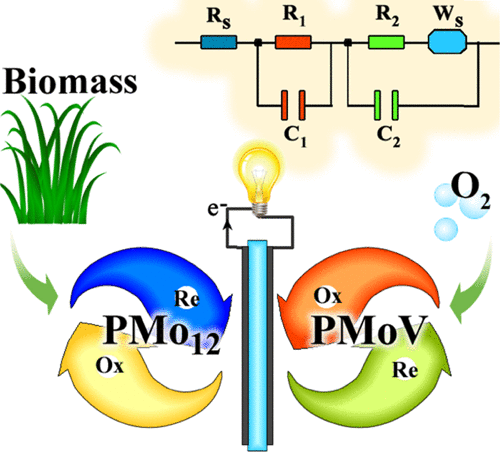当前位置:
X-MOL 学术
›
Ind. Eng. Chem. Res.
›
论文详情
Our official English website, www.x-mol.net, welcomes your
feedback! (Note: you will need to create a separate account there.)
Fundamental Study toward Improving the Performance of a High-Moisture Biomass-Fueled Redox Flow Fuel Cell
Industrial & Engineering Chemistry Research ( IF 3.8 ) Pub Date : 2020-03-02 , DOI: 10.1021/acs.iecr.9b06982 Wei Liu 1 , Yutao Gong 1 , Andrew Tricker 1 , Gaoxiang Wu 1 , Congmin Liu 2 , Zi-sheng Chao 3, 4 , Yulin Deng 1
Industrial & Engineering Chemistry Research ( IF 3.8 ) Pub Date : 2020-03-02 , DOI: 10.1021/acs.iecr.9b06982 Wei Liu 1 , Yutao Gong 1 , Andrew Tricker 1 , Gaoxiang Wu 1 , Congmin Liu 2 , Zi-sheng Chao 3, 4 , Yulin Deng 1
Affiliation

|
The approach using polyoxometalate (POM) as biomass oxidation catalysts and charge carriers in a flow fuel cell (FFC) is of great interest as it can directly convert biomass to electricity. However, the fundamentals, such as POM charge and discharge characteristics, electrode overpotentials, the regeneration of POMs in both cathode and anode cells, have not been understood. Studies focused on these fundamentals are critically important for improving the performance of these fuel cells. Herein, we constructed a POM-mediated biomass redox flow fuel cell (BRFFC) that generated power density as high as 42 mW cm–2 directly from various high-moisture contented raw biomass fuels, such as wheat straw, sugarcane, corn cob, green corn stover, and peanut shells. Different from previous studies, a new design of the flow fuel cell was constructed by inserting a Ag/AgCl reference electrode. This new design is unique because the discharging process, electrode overpotential, and electrochemical kinetics can be investigated in situ, which provides a deeper fundamental understanding of the biomass flow fuel cell. The results indicate that the POM discharging at the cathode electrode rather than the anode plays a key role in the entire flow fuel cell performance. The energy analysis shows that the biomass flow fuel cell used in this study can generate maximum net energy 2.33 MJ (647 Wh) by consuming 1 kg of 59.5% moistured wheat straw.
中文翻译:

改善高水分生物质燃料氧化还原流燃料电池性能的基础研究
在流动燃料电池(FFC)中使用多金属氧酸盐(POM)作为生物质氧化催化剂和电荷载体的方法非常受关注,因为它可以将生物质直接转化为电能。然而,尚未了解诸如POM的充电和放电特性,电极过电势,阴极和阳极电池中POM的再生等基本原理。专注于这些基础知识的研究对于提高这些燃料电池的性能至关重要。在此,我们构建了一种由POM介导的生物质氧化还原流式燃料电池(BRFFC),其产生的功率密度高达42 mW cm –2直接来自各种高水分含量的原始生物质燃料,例如麦秸,甘蔗,玉米芯,青玉米秸秆和花生壳。与以前的研究不同,通过插入Ag / AgCl参比电极构造了流动燃料电池的新设计。这种新设计是独特的,因为可以就地研究放电过程,电极超电势和电化学动力学,从而为生物质流燃料电池提供了更深的基础知识。结果表明,POM在阴极而不是阳极上放电在整个流动燃料电池性能中起着关键作用。能量分析表明,本研究中使用的生物质流燃料电池通过消耗1 kg含水量为59.5%的小麦秸秆,可以产生最大净能量2.33 MJ(647 Wh)。
更新日期:2020-03-02
中文翻译:

改善高水分生物质燃料氧化还原流燃料电池性能的基础研究
在流动燃料电池(FFC)中使用多金属氧酸盐(POM)作为生物质氧化催化剂和电荷载体的方法非常受关注,因为它可以将生物质直接转化为电能。然而,尚未了解诸如POM的充电和放电特性,电极过电势,阴极和阳极电池中POM的再生等基本原理。专注于这些基础知识的研究对于提高这些燃料电池的性能至关重要。在此,我们构建了一种由POM介导的生物质氧化还原流式燃料电池(BRFFC),其产生的功率密度高达42 mW cm –2直接来自各种高水分含量的原始生物质燃料,例如麦秸,甘蔗,玉米芯,青玉米秸秆和花生壳。与以前的研究不同,通过插入Ag / AgCl参比电极构造了流动燃料电池的新设计。这种新设计是独特的,因为可以就地研究放电过程,电极超电势和电化学动力学,从而为生物质流燃料电池提供了更深的基础知识。结果表明,POM在阴极而不是阳极上放电在整个流动燃料电池性能中起着关键作用。能量分析表明,本研究中使用的生物质流燃料电池通过消耗1 kg含水量为59.5%的小麦秸秆,可以产生最大净能量2.33 MJ(647 Wh)。











































 京公网安备 11010802027423号
京公网安备 11010802027423号